Insulin-like growth factor 1 receptor activation promotes mammary gland tumor development by increasing glycolysis and promoting biomass production
- PMID: 28173837
- PMCID: PMC5297135
- DOI: 10.1186/s13058-017-0802-0
Insulin-like growth factor 1 receptor activation promotes mammary gland tumor development by increasing glycolysis and promoting biomass production
Abstract
Background: The insulin-like growth factor 1 (IGF1) signaling axis plays a major role in tumorigenesis. In a previous experiment, we chronically treated mice with several agonists of the IGF1 receptor (IGF1R). We found that chronic treatment with insulin analogues with high affinity towards the IGF1R (IGF1 and X10) decreased the mammary gland tumor latency time in a p53R270H/+WAPCre mouse model. Frequent injections with insulin analogues that only mildly activated the IGF1R in vivo (glargine and insulin) did not significantly decrease the tumor latency time in this mouse model.
Methods: Here, we performed next-generation RNA sequencing (40 million, 100 bp reads) on 50 mammary gland tumors to unravel the underlying mechanisms of IGF1R-promoted tumorigenesis. Mutational profiling of the individual tumors was performed to screen for treatment-specific mutations. The transcriptomic data were used to construct a support vector machine (SVM) classifier so that the phenotypic characteristics of tumors exposed to the different insulin analogue treatments could be predicted. For translational purposes, we ran the same classifiers on transcriptomic (micro-array) data of insulin analogue-exposed human breast cancer cell lines. Genome-scale metabolic modeling was performed with iMAT.
Results: We found that chronic X10 and IGF1 treatment resulted in tumors with an increased and sustained proliferative and invasive transcriptomic profile. Furthermore, a Warburg-like effect with increased glycolysis was observed in tumors of the X10/IGF1 groups and, to a lesser extent, also in glargine-induced tumors. A metabolic flux analysis revealed that this enhanced glycolysis programming in X10/IGF1 tumors was associated with increased biomass production programs. Although none of the treatments induced genetic instability or enhanced mutagenesis, mutations in Ezh2 and Hras were enriched in X10/IGF1 treatment tumors.
Conclusions: Overall, these data suggest that the decreased mammary gland tumor latency time caused by chronic IGF1R activation is related to modulation of tumor progression rather than increased tumor initiation.
Keywords: Hallmarks of cancer; IGF1R; Mammary gland tumor; Next-generation sequencing; Warburg.
Figures
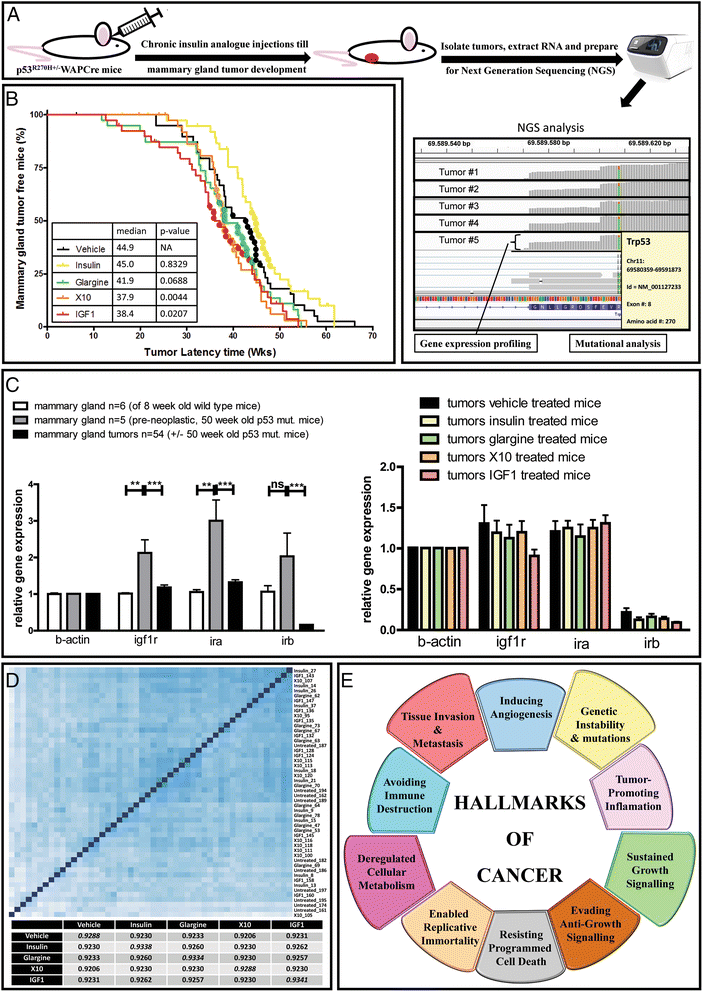
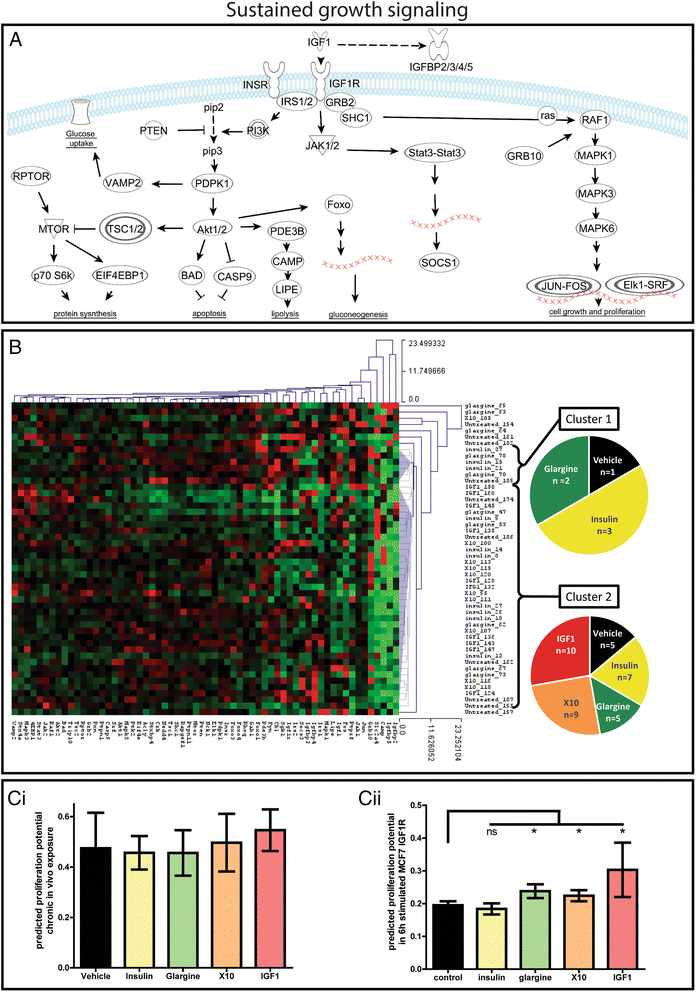
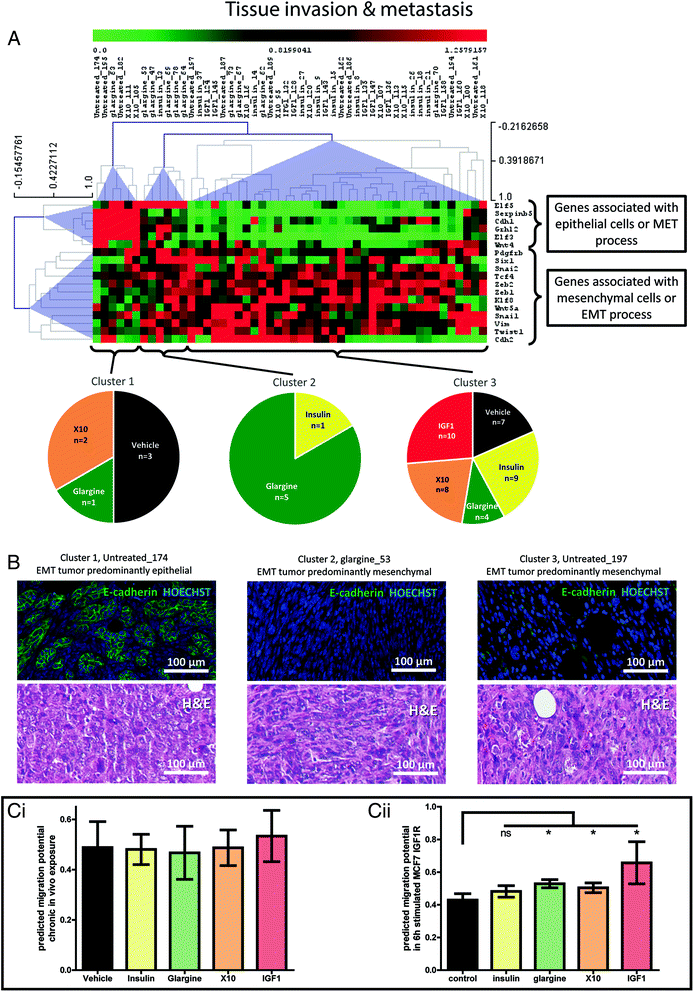

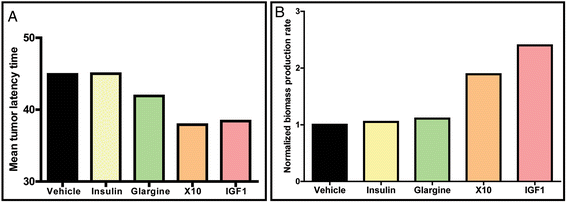
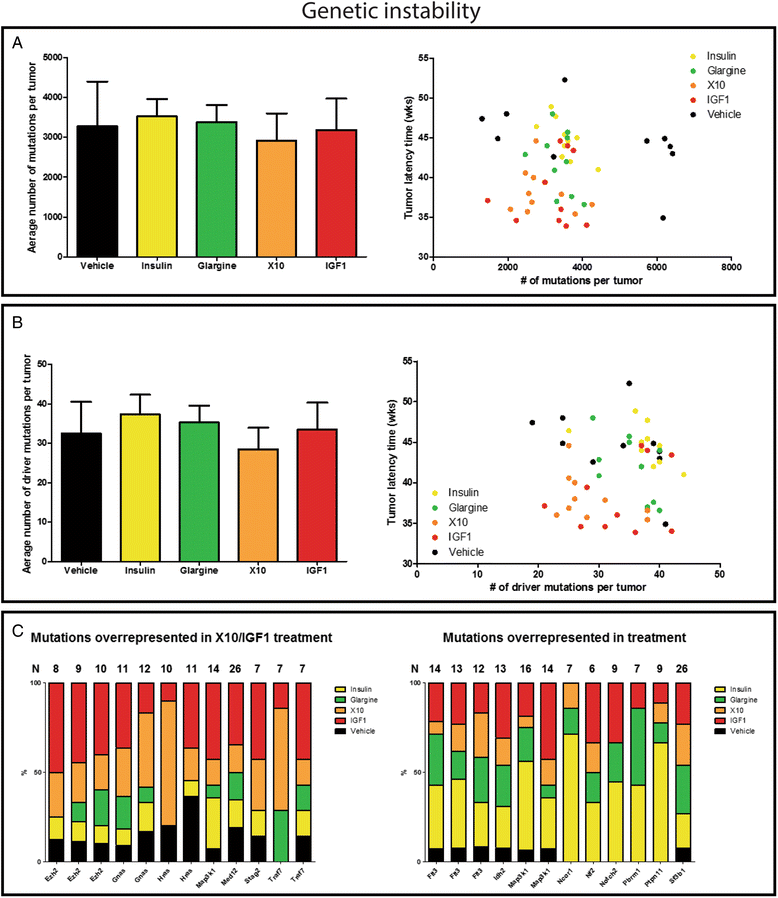
Similar articles
-
Mammary gland tumor promotion by chronic administration of IGF1 and the insulin analogue AspB10 in the p53R270H/⁺WAPCre mouse model.Breast Cancer Res. 2015 Feb 18;17(1):14. doi: 10.1186/s13058-015-0518-y. Breast Cancer Res. 2015. PMID: 25848982 Free PMC article.
-
Alternative signaling network activation through different insulin receptor family members caused by pro-mitogenic antidiabetic insulin analogues in human mammary epithelial cells.Breast Cancer Res. 2015 Jul 19;17(1):97. doi: 10.1186/s13058-015-0600-5. Breast Cancer Res. 2015. PMID: 26187749 Free PMC article.
-
ETV6-NTRK3-mediated breast epithelial cell transformation is blocked by targeting the IGF1R signaling pathway.Cancer Res. 2011 Feb 1;71(3):1060-70. doi: 10.1158/0008-5472.CAN-10-3096. Epub 2010 Dec 9. Cancer Res. 2011. PMID: 21148487
-
Crosstalk between insulin-like growth factor (IGF) receptor and integrins through direct integrin binding to IGF1.Cytokine Growth Factor Rev. 2017 Apr;34:67-72. doi: 10.1016/j.cytogfr.2017.01.003. Epub 2017 Feb 3. Cytokine Growth Factor Rev. 2017. PMID: 28190785 Free PMC article. Review.
-
Role of insulin-like growth factors in growth, development and feeding.World Rev Nutr Diet. 2013;106:60-5. doi: 10.1159/000342546. Epub 2013 Feb 11. World Rev Nutr Diet. 2013. PMID: 23428682 Review.
Cited by
-
Effects of insulin and analogues on carcinogen-induced mammary tumours in high-fat-fed rats.Endocr Connect. 2018 May;7(5):739-748. doi: 10.1530/EC-17-0358. Epub 2018 Apr 24. Endocr Connect. 2018. PMID: 29692348 Free PMC article.
-
Targeting acidity in cancer and diabetes.Biochim Biophys Acta Rev Cancer. 2019 Apr;1871(2):273-280. doi: 10.1016/j.bbcan.2019.01.003. Epub 2019 Jan 30. Biochim Biophys Acta Rev Cancer. 2019. PMID: 30708040 Free PMC article. Review.
-
The glutaminase inhibitor telaglenastat enhances the antitumor activity of signal transduction inhibitors everolimus and cabozantinib in models of renal cell carcinoma.PLoS One. 2021 Nov 3;16(11):e0259241. doi: 10.1371/journal.pone.0259241. eCollection 2021. PLoS One. 2021. PMID: 34731180 Free PMC article.
-
Resveratrol's Anti-Cancer Effects through the Modulation of Tumor Glucose Metabolism.Cancers (Basel). 2021 Jan 7;13(2):188. doi: 10.3390/cancers13020188. Cancers (Basel). 2021. PMID: 33430318 Free PMC article. Review.
-
Interleukin-1β mediates a tumor-supporting environment prompted by IGF1 in triple-negative breast cancer (TNBC).J Transl Med. 2025 Jun 17;23(1):660. doi: 10.1186/s12967-025-06730-w. J Transl Med. 2025. PMID: 40528195 Free PMC article.
References
-
- Varewijck AJ, Janssen JA. Insulin and its analogs and their affinities to the IGF-1 receptor. Endocr Relat Cancer. 2012;19(5):F63-75. - PubMed
-
- Ter Braak B, Siezen CL, Kannegieter N. Koedoot E, van de Water B. van der Laan JW. Classifying the adverse mitogenic mode of action of insulin analogues using a novel mechanism-based genetically engineered human breast cancer cell panel. Arch Toxicol. 2014;88:953–66. - PubMed
Publication types
MeSH terms
Substances
LinkOut - more resources
Full Text Sources
Other Literature Sources
Medical
Molecular Biology Databases
Research Materials
Miscellaneous

